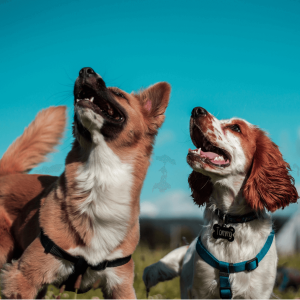
Ethologist Jordi Casamitjana explores the issue of happiness in dogs, including whether they are happy under a vegan diet.
The Pursuit of Happiness
It’s nice to be happy, right? This is what we all want. “Life, Liberty and the pursuit of Happiness” are, according to the US Declaration of Independence, three unalienable rights given to all humans, and which governments are there to protect. But why stop in humans? Why don’t’ we extend it to the rest of sentient beings? Why not extend it, at the very least, to humans’ bests friends, our beloved dogs?
We know dogs are alive—and deserve to be. We also know how much they thank us when we let them taste the freedom beyond their kennels and chains. But what about their happiness? What is happiness, anyway? It is an emotional positive state characterized by feelings of joy, satisfaction, contentment, and fulfilment.
Can Dogs Be Happy?

Most sentient beings can be happy because they prefer positive experiences created by their nervous system from the stimuli they perceive with their senses (which is what sentience is). All vertebrate animals have the same physiological and hormonal mechanisms we possess to feel happy. The limbic system is the part of the vertebrate’s brain which categorizes emotional experiences as either pleasant or unpleasant mental states — and neurochemicals such as dopamine, noradrenaline, and serotonin are important components of it. Most vertebrates (reptiles, birds and mammals like us) have this, so it makes sense that they would feel happy in a similar way we do.
However, for us humans, it is not always easy to know when they are happy by just observing them, especially if we go beyond primates — who express their happiness very similarly to us.
Nevertheless, anybody who has lived with dogs knows well when they are happy, scared, angry or sad. They may not necessarily know how they know, but they do know. Some say that dogs have the emotional and mental capacity of a 2.5-year-old child, meaning that, like us, they experience emotions like joy, fear, and anger. From all the animals we relate with daily, the emotions of dogs are the ones we probably are better at reading. This is because their life depends on it.
How Dogs Learnt to Show Us Happiness

When dogs evolved from one type of hunting wolves who lived about 30,000 years ago, not only they gradually changed their dietary adaptations from carnivores to omnivores but also became much better at communicating with humans. As they became adapted to “eat what their human companions eat”, they had to be able to ask for food in a very different way than wolves do. When wolves return from a day of hunting, the youngsters and other wolves left behind lick the muzzles and corners of the mouths of the returning hunters, which made them regurgitate some of the food from their stomachs to share.
This clearly was not going to work with humans. Dogs had to learn to ask for food with visual and auditory signals, not tactile. For instance, with their tail movements and body language, and by barking and vocalising.
Those dogs who did all these better became more successful as being chosen as companions, getting food, and breeding — which allowed them to evolve quickly from carnivore hunting wolves to omnivore scavenger dogs. That mouth licking behaviour, though, never completely disappeared — as many people who share a home with a dog know.
The Signs of Happiness in Dogs

We sometimes think that we know when dogs are happy because they wag their tail, but it is not as simple as that. In dogs, the tail does play a role in communicating with others, but it does not always mean happiness. If a dog is holding its body erect and rigid while wagging its tail, it may be telling you that it’s feeling territorial or uncomfortable with something.
Interestingly, research from M. Siniscalchi et al. showed that dogs looking at moving video images of other dogs wagging their tail more towards the left or the right showed more behaviour indicating anxiety when observing left- rather than right-biased tail wagging. We don’t quite know why this is. It’s not all about the tail, though.
Here are the most well-known physical signs of happiness in dogs:
- A high and waggy tail with whole-body wiggles
- Relaxed floppy ears (not pulled back or tight with alertness).
- Relaxed posture with a raised head and relaxed tail.
- Making a “play bow” (a playful posture with elevated rear, lowered chest to the ground, and open mouth without showing the upper teeth)
- A soft, partially open mouth
Their general behaviour can also be very informative about the dog’s mood. Happy dogs are less destructive, more playful, have a healthy appetite, and make a lot of body contact with others (dogs or humans).
Dogs are Happy Eating Vegan Dog Food

There has been a very recent study aimed to find out if dogs are as happy eating vegan dog food as the old-fashion meat versions. Conducted by Professor Andrew Knight and Dr Liam Satchell from Winchester University, it is titled: “Vegan versus meat-based pet foods: Owner-reported palatability behaviours and implications for canine and feline welfare.”
They surveyed 4,060 dog or cat guardians to determine the importance to them of pet food palatability, and the degree to which their animals displayed specific behavioural indicators of whether they were happy eating the food offered to them. The study compared three major dietary groups reported: conventional meat (1,370 dogs), raw meat (830 dogs) and vegan (336 dogs).
The dogs’ guardians were asked to report the extent to which they thought their dog displayed 10 behaviours (on a five steps scale from Strongly Disagree to Strongly Agree). These are the nine behaviours that indicate positive palatability when seen around the food given to the dogs:
1. Eating quickly
2. Approaching food quickly
3. Wagging tail
4. Jumping
5. Vocalising
6. Salivating
7. Licking lips
8. Staying near the food bowl
9. Guarding the food
The tenth behaviour was sniffing the food, a negative indicator of palatability that suggests the dog is not quite sure about it.
The authors concluded that, for the 2,308 dogs included in the study, reported observations of these ten behavioural indicators of palatability reliably indicated that there was no consistent evidence of a difference between vegan diets and either the conventional or raw meat diets. This means that dogs were as happy eating plant-based dog food as they were eating other types of dog food. And we also know that vegan dog food with the appropriate added nutrients is healthy for dogs. That’s good news for the dogs, the cows, the pigs, the chickens, the kangaroos and also many compassionate humans.
We are Happier when Dogs are Happier

If you live with a dog and feel somehow down or under the weather, you know how precious is to see the dog greeting you with a happy face and a wiggly body. You know how well you feel when you pat a happy dog. That’s the deal humans and dogs struck thousands of years ago when they began their friendship. In exchange for food, shelter and companionship, dogs changed from scary predatory howling wolves to run away from, to friendly barking happy dogs we love to pet and hug.
For me, seeing the black wet noses of fluffy dogs, shining above their tangling pink tongues, makes me smile. I can’t help it. It’s something very primaeval that has been embedded in our psyche.
When dogs are happy we feel happy too. But if all animals can be happy, they can be miserable, scared and sad too. If we make our companion dogs happy, what about the pigs and cows kept in factory farms in horrible conditions to be eventually killed and fed to dogs as conventional pet food? What about the kangaroos and bison who are chased, shot, injured and eventually killed to be fed to dogs as raw food? They all have the same limbic system in the brain responsible for experiencing suffering or pleasure. They all have the same hormones in their bodies to make them feel happy, sad, or scared.
How can we feel truly happy if we know the food we give to our companion canines is making other animals very unhappy? Once you know the ordeal these other animals go through, you cannot ignore it. But there is a way to remove that dark cloud from your conscience. There is now nutritiously balanced vegan dog food which not only makes dogs healthy but also happy, without making anyone else unhappy. And it’s better for the environment as well.
Now you can share happiness with your companion dog too. You can be happy when knowing that you are no longer contributing to the misery and death of any sentient being, and you are helping your best friends to have the best possible life.
The pursuit of happiness is everyone’s right. We all can help each other to attain it.
Jordi Casamitjana for HOWND
After Jo Amit, co-founder of HOWND, read Jordi Casamitjana’s book “Ethical Vegan: A personal and political journey to change the world”, she knew he was the right person to write this blog for HOWND to help people on their ethical journey and make the right decisions for their dogs too.








